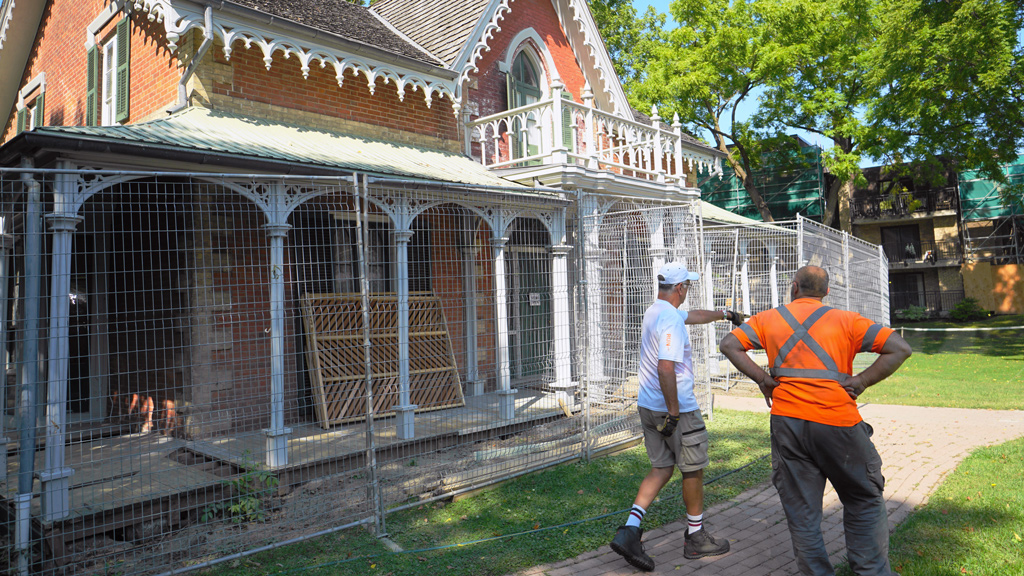Over the past few decades the Aurora Historical Society (AHS) has needed hundreds of thousands of dollars for the upkeep and restoration of its museum, Hillary House, a 159-year-old rare example of a purpose-built doctor’s office and residence standing prominently on Main Street in Aurora.
Now, the society is at it again, with repairs to the Gothic Revival brick museum’s Victorian front verandah.
Final costs aren’t tabulated and repairs to an undermined foundation in sections and step cracking in brick walls will add to the bill for the building, a designated National Historic Site.
The historical society’s budget for upkeep is tight, as is the budget of many small historic building owners, but hiring Toronto’s ERA Architects Inc. to do a condition report of the building has proven to be money well spent, says Patricia Wallace, president of the AHS.
ERA’s job, which has included drafting tender documents and assisting with the selection of a heritage builder to do the work, has helped the historical group set priorities on urgent repairs versus ones that can wait.
Other historic building owners with complex problems might be wise to follow the AHS’s path and retain a qualified heritage consultant but in many small towns in Ontario and across Canada where economic times are tough it can be difficult to justify any expense.
Philip Evans, principal of ERA, who has been involved in the Hillary House project and others across the province, is aware of the problem.
He says to keep many small town main streets from dying will require communities to refocus from single resource drivers such as farming, lumber, mining or fishing, to cultural or other drivers.
The “physical pillars” of most Ontario communities 100 years ago, “a church, a cute main street and a few barns,” might not be enough to sustain a community today, he adds.
Singling out a building for historic designation or demolition by itself won’t address a community’s sustainability, the consultant points out. Devising strategies around new uses is often paramount.
Unfortunately, Evans says, the province has never developed a framework of policies to identify the value and the possible treatment of small-town buildings.But some years ago ERA developed an internal program called the Culture of Small, partly aimed at identifying an economic framework for community pre-projects.
While adaptive reuse is not new to ERA, the consultant’s team started asking itself questions about what the reuse is and how it plays into the betterment of the community’s changing economy.
Rethinking small-town roles as places to live and attracting new residents through new economies is vital to curb population loss, Evans says.
He cites an example where ERA was involved in the makeover of a traditional bed and breakfast into the Drake Devonshire, a boutique hotel, not only for its economic returns but also because it offers residents in the small town of Wellington, Ont., “a different social gathering space.”
Evans says there are a number of examples around Wellington in Prince Edward County, two hours east of Toronto, where developments have been transforming the economic base from agricultural to cultural.
ERA was also retained on two other adaptive reuse projects in Caledon, north of Toronto, with the conversion of a barn into an event space and another into a brewery.
“These are pillars of the community that are now defining future growth in the same way that barns and churches did back in their day.”
Evans says a hurdle to such developments in some remote communities is the scarcity of skilled labour and appropriate materials for restoration work.
The pandemic has added obstacles but it has also caused some urban dwellers to visit the idea of moving to the country or smaller centres away from the rush, says Evans, noting ERA has received a number of enquiries about doing projects outside the city.
“It could frankly pave the way for municipalities to be open to change.”
Wallace says she sees a way forward for small communities if they make the right investments in their historic building stock.
“It takes vision (shared by the municipality) to know which buildings are worth restoring for their architectural heritage and which are worth repurposing with a nod to their history.”











Recent Comments
comments for this post are closed